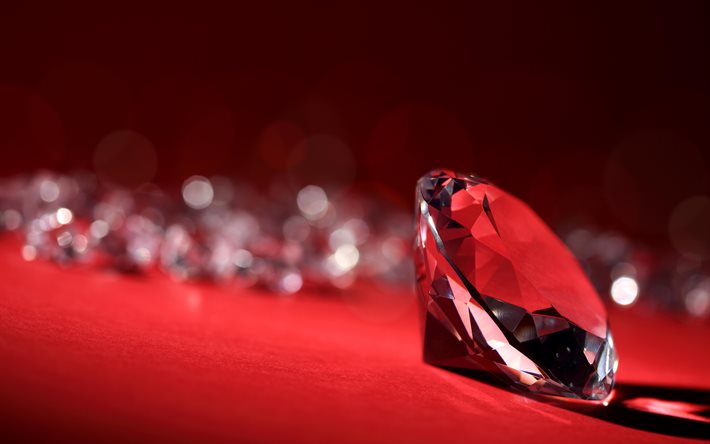Diamonds have long been a symbol of love, luxury, and prestige, often considered the ultimate choice for engagement rings and other fine jewelry. However, in recent years, diamond substitutes have gained popularity as ethical, affordable, and environmentally friendly alternatives to traditional diamonds. Whether due to concerns about the environmental impact of diamond mining or simply seeking a more budget-friendly option, many consumers are turning to these substitutes. In this article, we will explore the best diamond substitutes available today and what makes them appealing to those looking for alternatives to traditional diamonds.
Understanding Diamond Substitutes
Diamond substitutes are materials that replicate the appearance and brilliance of a natural diamond but come at a fraction of the cost. These alternatives are often chosen for their ethical and environmental advantages, as many are created in a lab or sourced from sustainable practices. While they may resemble diamonds in their sparkle and overall look, diamond substitutes can vary in terms of their chemical composition, durability, and visual appeal. Understanding the differences between diamond substitutes is crucial for anyone considering them as an alternative to traditional diamonds.
While diamonds are formed under extreme pressure and heat in the Earth’s crust over millions of years, diamond substitutes can be created through various means, including laboratory processes. These substitutes are often chemically different from diamonds but are designed to mimic the diamond’s characteristics, making them a popular choice for those looking for a more accessible and sustainable option.
Moissanite: A Leading Diamond Substitute
One of the most popular and well-known diamond substitutes is moissanite. Moissanite is a naturally occurring mineral that is made up of silicon carbide. While it is rare in nature, most moissanite on the market today is lab-created. Moissanite is incredibly durable, scoring 9.25 on the Mohs hardness scale, making it a highly resistant material that is perfect for everyday wear. Its brilliance and sparkle are another reason it is a favored diamond substitute. Moissanite has a higher refractive index than diamonds, which means it can reflect more light, giving it an extra sparkle that many people find appealing.
What sets moissanite apart from traditional diamonds is its affordability. Moissanite is significantly less expensive than diamonds, allowing consumers to purchase a larger or higher-quality stone without breaking the bank. For those looking for a brilliant stone with the appearance of a diamond, moissanite is a top diamond substitute that combines beauty, durability, and cost-effectiveness.
Lab-Grown Diamonds: A Sustainable Diamond Substitute
Lab-grown diamonds are another popular diamond substitute that has become increasingly sought after. These diamonds are chemically and structurally identical to natural diamonds, meaning they have the same hardness, brilliance, and appearance. However, unlike mined diamonds, lab-grown diamonds are created in a controlled laboratory setting, using either High Pressure High Temperature (HPHT) or Chemical Vapor Deposition (CVD) techniques. The process of creating lab-grown diamonds produces minimal environmental impact compared to traditional mining methods.
The key appeal of lab-grown diamonds as a diamond substitute lies in their sustainability and ethical production. Since they do not require the destruction of ecosystems or exploitation of workers, lab-grown diamonds are seen as an ethical and eco-friendly choice. Additionally, lab-grown diamonds are typically more affordable than mined diamonds, making them an attractive alternative for those who want the same quality but at a lower price. For consumers who prioritize environmental and ethical considerations, lab-grown diamonds are a top substitute to traditional diamonds.
White Sapphire: A Budget-Friendly Diamond Substitute
White sapphire is another well-known diamond substitute that offers a more budget-friendly option for those seeking the appearance of a diamond. White sapphires are naturally occurring gemstones that are highly valued for their clarity and beauty. They are often colorless or near-colorless, which makes them resemble diamonds closely. While white sapphires do not have the same brilliance or fire as diamonds, they are still a beautiful and durable alternative that can be used in various types of jewelry.
One of the main benefits of choosing white sapphire as a diamond substitute is its affordability. White sapphires are much less expensive than diamonds, making them a great option for those on a budget or those who want to purchase a larger stone for the same price. Though they may lack the sparkle of diamonds, white sapphires offer an elegant and classic look, making them a popular choice for engagement rings and other fine jewelry.
Cubic Zirconia: The Most Affordable Diamond Substitute
Cubic zirconia (CZ) is one of the most affordable diamond substitutes available on the market. Made from synthetic zirconium dioxide, cubic zirconia has been used as a diamond imitation for decades. While it is not as durable or hard as diamonds, scoring 8 to 8.5 on the Mohs scale, cubic zirconia still offers a sparkling appearance similar to diamonds, making it a popular choice for costume jewelry or pieces that may not see frequent wear.
Cubic zirconia is highly affordable and widely available, making it a great option for those looking for a temporary or budget-friendly alternative to diamonds. It is also customizable, available in various shapes, sizes, and colors, which allows for greater flexibility in design. While cubic zirconia may not be as durable as other diamond substitutes, its affordability and visual appeal make it a top choice for anyone looking for a cheap alternative to diamonds.
The Appeal of Colored Diamond Substitutes
In addition to the traditional colorless diamond substitutes, colored gemstones such as moissanite, sapphire, and even topaz can be excellent alternatives to diamonds. These colored gemstones offer a unique twist on the classic diamond look, allowing for a more personalized and distinctive piece of jewelry. Many people choose these colored substitutes because they are both beautiful and affordable, with some offering a higher degree of brilliance than diamonds.
Colored gemstones can provide a striking alternative to the traditional diamond, offering vibrant hues that lab grown diamonds cannot replicate. For example, sapphires come in a range of colors, including blue, pink, and yellow, and are known for their durability and brilliance. When paired with the right metal, these colored gemstones can offer a unique and stunning look while still serving as a diamond substitute.
Why People Choose Diamond Substitutes
The primary reason many consumers turn to diamond substitutes is the combination of ethical, environmental, and financial concerns. Mined diamonds can be expensive, and their production often involves significant environmental destruction and human rights concerns. Diamond substitutes, such as moissanite, lab-grown diamonds, and white sapphires, offer consumers the opportunity to enjoy the beauty and durability of a diamond without the negative impact on the planet or people.
Additionally, many diamond substitutes are significantly more affordable than traditional diamonds, allowing consumers to purchase a larger or higher-quality stone without sacrificing style or appearance. For individuals seeking the brilliance and elegance of diamonds but at a more accessible price point, diamond substitutes present an ideal solution.
Conclusion: Diamond Substitutes as the Future of Fine Jewelry
In conclusion, diamond substitutes have emerged as a popular and viable alternative to traditional diamonds. Whether you are drawn to moissanite for its brilliance, lab-grown diamonds for their ethical and environmental benefits, or white sapphires for their affordability, there are many excellent options available to consumers. Diamond substitutes offer a variety of benefits, from cost savings to sustainability, without sacrificing the beauty and elegance associated with diamonds. As consumer preferences continue to shift towards more ethical and affordable options, diamond substitutes are likely to play an increasingly important role in the jewelry market.



